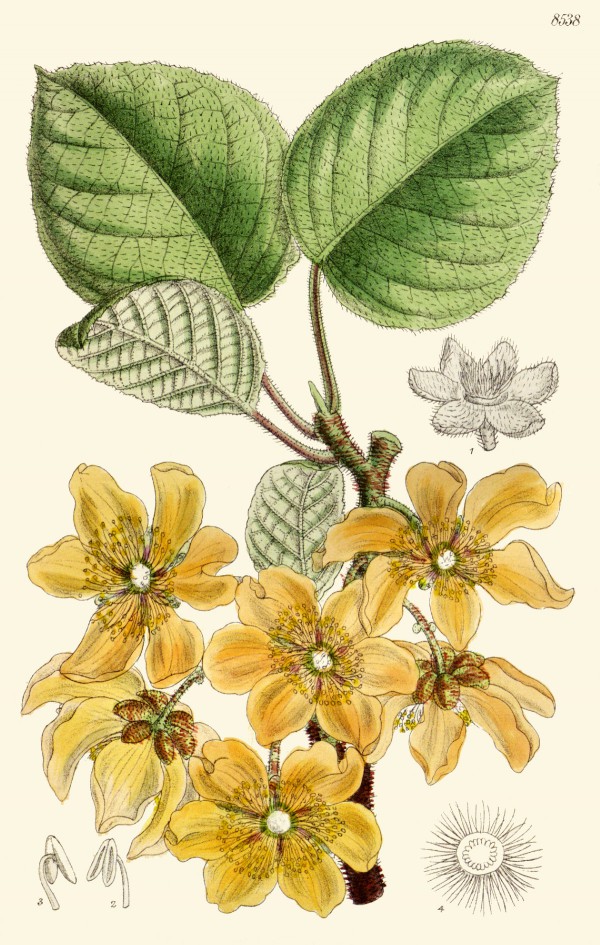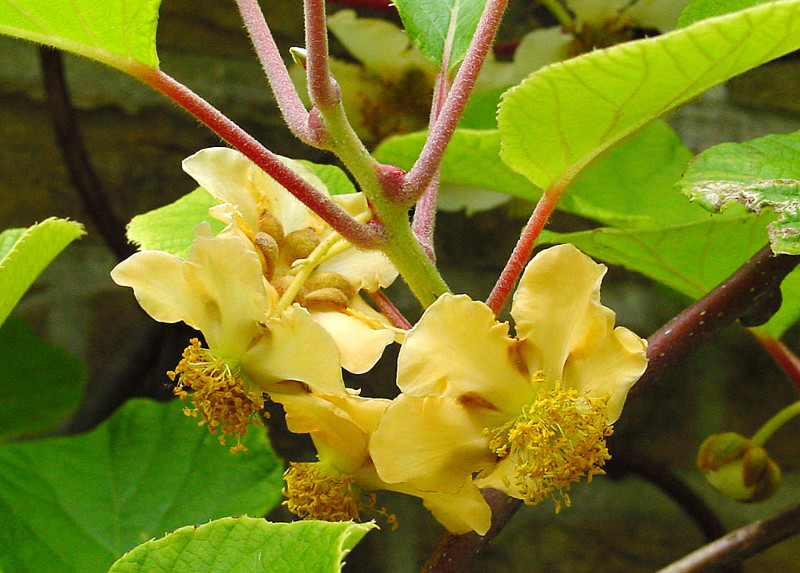Dies ist eine alte Version des Dokuments!
Actinidia chinensis Planch. - Actinidiaceae - golden kiwi, Chinese soft-hair kiwi, Chinesischer Strahlengriffel, Gold-Kiwi
„The volatile constituents of kiwifruit (Actinidia chinensis Planch.) have been investigated. The volatiles were collected and concentrated using vacuum steam distillation and freeze concentration. The concentrated distillate was analysed by gas chromatography, gas chromatography-mass spectrometry and reaction gas chromatography. Apart from methyl benzoate, all the components identified were alkyl and alkenyl esters, alcohols, aldehydes and ketones. The most abundant component was trans hex-2-enal. Odour evaluation of the components at the exit port of the gas chromato-graph indicated that ethyl butanoate, hexanal and trans hex-2-enal are important contributors to the aroma of kiwifruit. One other component which does not show a peak in the chromatogram and which is not yet completely characterised may have particular significance.“
[Volatile aroma constituents of kiwifruit., Young, H., Paterson, V. J., Burns, D. J., Journal of the Science of Food and Agriculture, Vol.34(1), 1983, 81-85]
Essential components of the fresh kiwi flavor are butyric acid esters, as well as unsaturated C-6-aldehydes and alcohols, especially 2-hexenal, 2-hexenol, hexanol and hexanal. The unsaturated compounds develop rapidly on maceration of the fruit but reduce in short-term storage of the mash, in deep-freezing or storing the fruit for a short time at temperatures just above the freezing point. In frozen kiwi puree, as well as in whole fruits stored for too long, terpenyl esters, especially linalyl acetate, isobornyl acetate and terpinyl acetate, but also linalool, are found. On the other hand, the content of C-6 aldehydes, C-6 alcohols and butyric acid methyl ester decreases.
[Pfannhauser, Werner. „Sensorische und instrumentelle analytische Untersuchungen des Kiwi-AromasSensorial and instrumental analytical investigations of Kiwi flavour.“ Zeitschrift für Lebensmittel-Untersuchung und Forschung 187.3 (1988): 224-228]
„Comparisons were made between the aroma volatiles of the yellow-fleshed kiwifruit, “Hort16A”, at two different stages of eating ripeness: firm and soft… A GC-sniffing study showed that many of the most intense compounds, acetaldehyde, hexanal, ethyl butanoate, and (E)-2-hexenal but not ethanol, showed odor activity in macerated fruit. In addition, dimethyl sulfide (DMS), a volatile present at very low levels in the fruit, also appeared to be an important contributor to the odor. In vivo analyses also showed much higher levels of aroma compounds in the soft fruit compared to the firm fruit, with evidence of persistence of some compounds, including DMS.“
[In vitro and in vivo release of aroma compounds from yellow-fleshed kiwifruit., Friel, E. N., Wang, M., Taylor, A. J., MacRae, E. A., Journal of agricultural and food chemistry, Vol.55(16), 2007, 6664-6673]

Actinidia chinensis, Curtis’s Botanical Magazine, t.8532-8591, vol.140 [ser.4, vol 10] t.8538 (1914) [M.Smith]
http://plantgenera.org/species.php?id_species=18341

flowers, author: Wouterhagens CC BY-SA 3.0
Wikimedia Commons
Actinidia chinensis fruits
© Rolf Marschner (2016),
www.botanische-spaziergaenge.at
